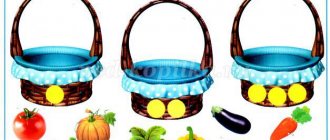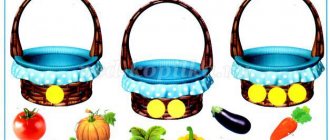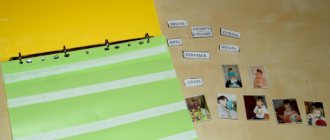How expressive speech manifests itself in preschool age
The expressiveness of speech depends on the age of preschoolers and is manifested in sound, emotions, gestures, intonation, and words.
It appears when a child tries to convey not only information, but also an emotional attitude towards it.
The expressiveness of his everyday speech depends on many factors, including temperament. A preschool child begins to retell and recite with expression and semantic accents only with the guidance of an adult - when he is purposefully taught to highlight the most important things in statements.
What does intonation expressiveness of speech include?
The intonation expressiveness of preschool children’s speech is formed in the process of communication and by imitation. It is a combination of the following components:
- melodics (raising and lowering the voice);
- timbre (voice color);
- tempo (speeding up and slowing down speech);
- logical stress (highlighting the main meaning of a word or group of words);
- rhythm (uniform alternation of stressed and unstressed elements of speech);
- pause (short break in speech).
Speech is enriched with certain intonations and expressiveness by about 5 years, when the development of speech in preschool children rises to a higher level.
Natural emotionality in children's speech
The formation of the expressiveness and tone of a child’s speech begins in early childhood. First, the baby says something emotionally, sharing his impressions of what he saw or heard: he stroked the cat - he enthusiastically reports it as best he can; does not want to eat porridge - he mumbles something, refusing.
At the same time, the preschool child does not think about the spoken words and often does not pronounce all the sounds. But the main thing is emotions. Everything happens naturally and sometimes makes adults smile.
We recommend that you read: Speech development in children 3-4 years old.
When interacting with peers or adults, a child can be quite emotional. In children, the brightness of speech is spontaneous and depends on the feelings and emotions experienced. Children aged 5-6 years have a desire to use words that they hear from adults in cartoons and fairy tales.
When addressing others, children try to copy the emotional coloring that they remember in the speech of adults or the heroes of their favorite works.
The child uses the previously heard speech of an adult as a model. Parents should remember: the richer their vocabulary and the brighter the expressiveness of their speech, the more opportunities the child has to master the art of speaking.
Conscious expressiveness when retelling and reciting
As the child grows up and gains experience, he moves to voluntary, conscious expressiveness of messages.
One of the methods for developing expressive speech is retelling text and reciting poems. In this case, the child relies on a ready-made speech sample. Adults can consistently and regularly train children's speech.
To do this, it is convenient to use the following algorithm:
- Read a short text or poem expressively.
- Talk about what is described in what you read.
- Clarify the meaning of complex words and expressions found in a text or poem.
- Read the text again. If this is a poem, then memorize several lines together.
- Invite the preschooler to retell it independently. You can introduce a game motivation: “Tell a story (poem) to a bear (dad, brother...)”
- Praise for an accurate and emotional retelling (story).
It is very important to ask questions during the process that focus on the expressiveness of the transfer of images. At the same time, the emotional coloring is intertwined with the meaning of words.
For example, the fairy tale: “Little Red Riding Hood”. How does Little Red Riding Hood talk? And grandma? How does the wolf speak to Little Red Riding Hood (loudly, quietly, affectionately, evilly)? Why? What does his speech sound like at first? And at the end of the fairy tale? What caused the changes? If children find it difficult to answer, then an adult should help them, explain, show them.
How to train stress and intonation?
To work on intonation, you should use the most popular proven techniques. But the most important thing is to listen and read a lot. It is better to pronounce high-quality texts out loud, paying attention to punctuation marks; similarly, it is good to listen to recordings of poetry readings or theatrical performances. This will help you grasp the subtlety of intonation, understand its meaning and importance.
Today, logical stress, intonation, timbre, pauses and much more in speech are placed incorrectly, so the meaning is difficult. In order to train your correct speech skills, you should perform a number of simple exercises. An example of the first is the famous phrase “Execution cannot be pardoned.” In it, fate and life depend on the correct intonation and, accordingly, the punctuation mark. It is also useful to read poems and phrases, emphasizing the meaning of certain words. At the same time, a change in the meaning, and therefore the result of speech, is demonstrated.
It is extremely important not to forget about training, hone correct breathing, take into account logical accents in speech and punctuation marks when reading.
Means for developing intonation expressiveness of children's speech
Means for developing intonation expressiveness in children are aimed at developing the most important speech skills:
- correct intonation of the text;
- accurate pronunciation of sounds;
- to eliminate errors when placing stress in words;
- to develop the ability to pause when it is necessary to focus attention on a word or group of words.
Particular attention is paid to facial expressions, gestures and plasticity. They help children feel the corresponding states, touch those experiences that need to be expressed in a statement.
All of these characteristics must be developed through games, exercises, and theatrical performances.
Exercises to train intonation
Exercises to train intonation should be carried out in the form of task-games so that the child has a desire to complete it.
For example, “Say hello in accordance with the emotion of the pictogram” (emoticons with different emotions are used), “Say a sentence with a given intonation (fun, sad, scared, angry, surprised, sad”),” “Say “sunny” (bunny, car etc.) first loudly, and then quietly”, “Meow like a mother cat, and then like a little kitten”, “Shout “Aww” close (loudly) and far (quietly).”
For exercises, you can use color pictures, cards, toys. For older preschoolers, cards with words where the emphasis is indicated help them learn to calmly recite poetic lines. (Practice: “At LukomOrya the oak tree is green.”)
Games to develop speech expressiveness
Facial expressions, gestures, and expressive movements provide an additional opportunity to enhance the impact of speech on the interlocutor, to convey thoughts and feelings more clearly and imaginatively. Therefore, it is so necessary to develop nonverbal means of expressiveness in a preschooler.
For this purpose, special games can be played for children over 5 years old:
- To develop the ability to convey emotions and feelings: “Delicious candies”, “Bitter medicine”, “A long-awaited gift” and others.
- For the development of plastic arts: “Pantomime the proverb.”
- For the development of facial expressions: “The boy got angry”, “Focus”, “Scary Fairy Tale” and others.
- On the development of gestures: “I won’t show you,” “I don’t know,” etc.
- Combining acquired knowledge and skills. The child is invited to combine text, facial expressions, and gestures in the plot. For example, “Cloud”: “Suddenly a menacing monster flies across the sky and angrily threatens me with a huge fist.”
Riddles and tongue twisters
Riddles and tongue twisters for children contribute to the development of expressive speech. Many riddles are invented in such a way that their guessing is facilitated by expressive pronunciation, complemented by appropriate facial expressions.
The adult’s task is to pronounce the riddle in such a way that the children can guess who or what they are talking about. Everything is important: clarity of text pronunciation, emphasis, timbre, facial expressions, and gestures.
I won’t tear the rosy Matryoshka away from my friends,
I’ll wait until Matryoshka falls into the grass on its own. (Apple)
Select several riddles, and then invite the child, accompanied by facial expressions and gestures, to pronounce the riddle so that other children can solve it.
Tongue twisters contribute to the development of clarity and melody of speech. They can be on a certain sound, theme, funny, classic, etc. For example, a tongue twister for training the sound “ch”: Four turtles have four little turtles. Or modern: Coconut makers boil coconut juice in coconut cookers.
Using the repetition technique, children learn tongue twisters by heart and explain that they must be pronounced quickly, while pronouncing the words carefully.
Both riddles and tongue twisters are perceived by children as a mini-game, evoke positive emotions and are therefore very productive when used in working with children.
Techniques of theatrical activities
Theatrical activities help the child to assimilate the richness of his native language, its means of expression, and use various intonations that correspond to the character of the characters and their actions. What techniques can be used with preschoolers?
- Dramatization games. Playing short fairy tales and original texts.
- Showing the emotional states or characters of famous heroes (Malvina, Carlson, The Snow Queen, Kikimora and others).
- Simulation of real life situations.
- Dialogues using toys, puppets, finger puppets and other types of theater.
A selection of didactic games and exercises for the development of figurative speech in older preschoolers.
A selection of didactic games and exercises for the development of figurative speech in older preschoolers.
1."At the exhibition".
Purpose: to describe the picture using figurative words and expressions.
Progress of the game: The teacher places children's drawings on an easel or in a group room and organizes an exhibition. Appoints a guide who conducts a tour of the exhibition. The guide must beautifully describe the paintings and give them names. If a child has difficulty with something, the children help him. The teacher regulates the frequency of tour guide changes. At the end of the game, the best tour guide is chosen.
2. “Let’s paint a picture with words.”
Goal: To develop children’s imagination, the ability to use words and figurative expressions that are accurate in meaning in descriptions.
Progress of the game: Educator: Children, do you want to become extraordinary artists who draw not with paints and pencils, but with words? Then get ready to draw. I will read you a gentle poem about winter, and you close your eyes and try to imagine what I will read about. Then tell me what kind of picture you got. But it must be told in such a way that everyone can mentally imagine this picture. Children can then paint illustrations for their stories. For this task, two fragments of the novel by A.S. are proposed. Pushkin “Eugene Onegin” and an excerpt from the poem “Winter Evening! Under blue skies Magnificent carpets Glistening in the sun, the snow lies. She came, crumbled into shreds, hung on the branches of oak trees; Lay down in wavy carpets Among the fields, around the hills. The storm covers the sky with darkness, spinning snow whirlwinds; Either she will howl like a beast, or she will cry like a child.
3. «Mystery".
Goal: identify the characteristics of objects, come up with riddles using figurative words and expressions. Material: Each player has a picture upside down. Assignment: Come up with a riddle based on the picture and tell it to everyone present. The winner is the one who comes up with the most interesting riddles, chooses comparisons, descriptions, and “beautiful” words for his riddle. Game option: Purpose: To develop imagination, the ability to expressively convey content and characters using words. An adult chooses one or two players who, using dolls, hats or other attributes, act out an episode or dialogue from a literary work. Children guess which fairy tale or story this passage is from. Whoever guesses first and says what preceded this episode, and what actions in the work will follow it, will have the right to be the first to guess the next riddle. The game is repeated several times.
4. “Who is more attentive?”
Purpose: To highlight figurative expressions and specific literary expressions in a literary text. Game rule: the one who notices and names more fairy-tale expressions and figurative words wins.
Progress of the game: Educator: Different peoples live on earth. And every nation has its own fairy tales. Folk tales can be easily distinguished from original literary works, because they contain special fairy tale words and songs. Now I will tell you a fairy tale that you already know. Listen carefully and try to notice such words. After reading a fairy tale, children name specific fairy tale expressions. Each correct answer is marked with a token.
5. “I’ll start, and you continue.”
Goal: select figurative words and expressions that are most appropriate in meaning. The teacher makes up unfinished sentences. The child must complete the sentence using figurative figures of speech. - It was a clear frosty day, snow in the sun... (sparkled, sparkled, shimmered, sparkled). - Misha sat on the sled and rushed down the mountain... (like a bullet, a whirlwind, an arrow, lightning). - The sled turned over, and the boy... (flopped, flopped, flew head over heels, fell into the snow). — Kolya really wanted the slide to work out. He worked... (tirelessly, tirelessly, by the sweat of his brow).
6. "Error".
Goal: To become familiar with figurative words and expressions, to find semantic inaccuracies and errors. The children are told that Dunno, who now goes to the school of cheerful men, wrote to them in a letter that he had learned to write sentences. They read the sentences that Dunno came up with and ask questions: - Masha lay tirelessly in bed all day long. (Why are you laughing? How should I say it differently?). “When Olya saw what a gift they brought her, she puffed up her lips with joy. - Oh, lion, you are so brave! You have a rabbit soul! — The old man with a stick rushed along the path, and Sasha wandered into the sandbox.
7. “What does the proverb say?”
After a conversation about the meaning of a proverb, the adult offers to compose a story in which one of the characters could say this proverb. Children can draw an illustration for the proverb. Children can be offered the following proverbs: “Fear has big eyes”; “A wolf is a stump for a cowardly bunny”; “Don’t dig a hole for someone else, you will fall into it yourself”; “Whoever sits in vain has a headache”; “Like the sleigh, so are you”; “One bee does not carry much honey.”
8. Who can remember more proverbs?
The adult offers the child to choose proverbs for a specific literary work, a specific episode of a fairy tale, or a plot picture. Another option is that an adult gives a proverb, examines it together with the children, and then offers to draw a picture and come up with a short story based on this proverb.
Games to familiarize children with synonyms.
Storyteller: Hello, guys. Today I want to introduce you to magic words - synonyms. These words make speech very beautiful and expressive. In my country, all residents use synonyms in their speech. Do you want to know these words? Children: Yes! Storyteller: Synonyms are words that sound and are spelled differently, but mean the same thing or are very close in meaning. Examples of synonyms: Moment - moment, Scold - scold, Huge - huge, In vain - in vain. There can be not only pairs of words, but also whole chains, rows: blizzard, blizzard, blizzard, blizzard, blizzard; briefly, briefly. Concisely, briefly. Synonyms are words that are close in meaning. They can replace each other.
1. Make up a sentence with synonyms
: Brave, courageous, daring. Courageous, fearless.
2. Name words in the sentence that are similar in meaning
. The task is difficult. The task is difficult. The puppy is timid. The kitten is timid. The balls are red. Scarlet flowers. Wonderful day. Good man. Fun mood. Happy event.
3. "Hunting for synonyms."
The driver leaves the room. The rest come up with a word and distribute synonyms for it among themselves. The guesser enters and asks questions. In answering the question, each participant must use the synonym assigned to him. Having memorized the synonym, the driver must guess the word. The player in the game becomes the driver. He uttered a phrase, after which it became clear what word was intended. You can suggest the following words: Bad, big, smart, move, clean, student, teach, run, brave, gloomy, talk.
4. “Make a proposal.”
The players need to remember phraseological units. Assignment: include phraseological units in the composed sentence. The players make up a sentence with phraseological units in a circle; whoever finds it difficult or makes a mistake leaves the game. The last one to play is the winner. Games to familiarize children with antonyms.
5. “Finish the sentence.”
The bush is low, and the tree is a large carriage, and the cart is liquid milk, and sour cream is sweet raspberries, and cranberries are . Speech exercises.
6. “What does it look like?”
Goal: Learn to find similarities in objects, give verbal comparisons using the words “as”, “as if”, “Like”. Material: pictures depicting a chicken, dandelion, pear, light bulb, bell, bell, cucumber, crocodile, orange leaf, flame, lined notebook, tiger, bouquet of flowers, butterfly.
Progress of the game: Pictures depicting a chicken, dandelion, pear, bell, bell, light bulb are laid out in front of the children. Children must find pairs of objects that are similar in some way. The teacher shows a sample of completing the task. He chooses a chicken and a dandelion and says: “the chicken looks like a dandelion.” Children should be able to make comparisons: “A pear is like a light bulb,” “a bell is like a bell.” Further the task becomes more complicated. New pictures are added, and now children find similar objects, highlighting and naming the comparison: “A hedgehog is as prickly as a Christmas tree,” etc.
7. “Why are they similar?”
Goal: to consolidate the ability to identify a comparison feature and name it. Material: pictures depicting fly agaric, ladybug, hats; snow, water, ice cream; tiger, zebra, hornet, etc. Progress of the game: Children are given pictures depicting a tiger, a fly agaric, a ball, and snow. Then other groups of pictures are laid out in front of them, among which they must select two objects similar to the one in their hands and compare them, highlighting the signs: “A tiger is as striped as a zebra, and its color is similar to a hornet,” etc. d.
8. "Flower Meadow"
Goal: Learn to write figurative descriptions. Material6 large didactic picture “Forest clearing” with slots into which paper flowers (bells, daisies, cornflowers, etc.) are inserted. Progress of the game: Children sit in a semicircle near the painting and take turns asking the clearing for a flower, name it correctly, and praise it using figurative words. Helping children. The teacher reads poems and asks riddles, draws the children’s attention to the characteristics of flowers in them: “A buttercup grew near the speech, it was thin, like a twig,” etc. At the end of the game, the teacher asks: “Who do you think has the most beautiful bouquet? Why? “- and shows an example of evaluation: “I really like Anya’s bouquet, because it contains forget-me-nots. Like blue eyes, and scarlet carnations, like flames, so bright that you can see them from afar.” This technique helps children remember definitions and comparisons in each other's answers.
9. "Guess the nickname."
Goal: To teach children to come up with figurative words that characterize toy characters. Material: red fox and black puppy. Progress of the game: Toys come to visit the children. Plush friends invite children to guess their names. Educator: they have such names. That you can immediately guess who is who. What do you think the little fox's name is? The little fox is cunning and has a fluffy tail. He is red, almost orange. Like a sun. What might his name be? (Children's answers). Little fox, is your name red? Children can name different nicknames, when their imagination runs out, the teacher prompts, on behalf of the little fox, “my name is Ogonyok.” The puppy is characterized similarly. Then the guests offer to find out the name of their gnome friend, who loves to sleep (he always grumbles, sneezes endlessly, loves cleanliness)?
10.“Listen to my word and complete the drawing.”
Goal: to consolidate ideas about polysemantic words, to communicate freely in the process of drawing. Materials: sheets of paper, felt-tip pens. Game actions: display in a picture the understanding of a polysemantic word. Progress of the game: I will name different words, and you imagine what it is and draw it. Words: pen, needle, pipe, etc. When the drawings are completed, the teacher offers to tell what drawings the children drew, the conclusion is drawn that different words were drawn for the same word.
11."Which? Which? Which?"
(Selection of definitions). Material: pictures of an apple. Pears, foxes, squirrels, hedgehogs; chips. Game actions: choose as many definitions for the word as possible. Rules: Do not repeat a word that has already been spoken. The teacher invites the children to play with words. I will name the object, and you describe it. Like artists. - Apple. What is it like? (round, juicy, ripe, pourable). If the children find it difficult, the teacher asks leading questions: how to say about a hedgehog so that it is clear that his body is covered with thorns and is afraid of a fox. For each determination, a chip is issued. At the end of the game, the chips are combined and a conclusion is drawn: for each word you can match many other words. Which will characterize it.
Bibliography:
1. Game and preschooler. Development of children of senior preschool age in play activities. Collection/ed. T.I. Babaeva, Z.A. Mikhailova. St. Petersburg, 2004.
2. Illarionova Yu.G. Teach children to solve riddles / Yu.G. Illarionov. – M.: Enlightenment, 1985. 3. Come up with a word. Speech games and exercises for preschoolers / Ed. O.S. Ushakova. M.: Education, 1996.
4. Say it differently / Speech games, exercises, situations, scenarios / Ed. O.S. Ushakova. – Samara, 1994.
5. Smart questions. Quizzes for preschoolers. – Author - comp. T.A. Evtyukova. – Novosibirsk: Sib. Univer. Publishing house, 2008.
6. Ushakova O. S. Speech development of a preschooler. – M.: Publishing House of the Institute of Psychotherapy, 2001. – 237 p.
The importance of expressive speech for the overall development of a child
Work on the formation of intonation expressiveness of a child’s speech will not disappear without a trace. Soon the preschooler will cross the threshold of school and find himself in a new environment. It's no secret that an emotionally charged word is an attractive tool when conducting a dialogue. A person who can speak expressively is listened to with interest.
It is easier for a child with vivid emotional speech to establish contacts, express his thoughts, write an essay, and present given material in class. The child is growing up. The skillful use of linguistic means in various communication situations determines the level of his speech competence, is an indicator of general culture, and influences the perception of the surrounding society.








